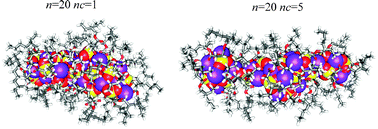A molecular dynamics study of structure, stability and fragmentation patterns of sodium bis(2-ethylhexyl)sulfosuccinate positively charged aggregates in vacuo†
Abstract
Positively charged supramolecular aggregates formed in vacuo by nAOTNa (

Maintenance work is planned for Wednesday 1st May 2024 from 9:00am to 11:00am (BST).
During this time, the performance of our website may be affected - searches may run slowly and some pages may be temporarily unavailable. If this happens, please try refreshing your web browser or try waiting two to three minutes before trying again.
We apologise for any inconvenience this might cause and thank you for your patience.
* Corresponding authors
a
Dipartimento di Scienze Biomediche e Biotecnologie, Universita` di Brescia, Viale Europa 11, 25123 Brescia, Italy
E-mail:
longhi@med.unibs.it
b CNISM, Consorzio Interuniversitario Scienze Fisiche della Materia, Via della Vasca Navale 84, 00146 Roma, Italy
c Dipartimento STeMBio, Via, Archirafi 32, 90123 Palermo, Italy
d Centro Grandi Apparecchiature, UniNetLAb, Via, F. Marini 14, 90128 Palermo, Italy
e Dipartimento di Tecnologie dell'Informazione, Università di Milano, Via, Bramante 65, 26013 Crema (CR), Italy
f Dipartimento di Chimica “S. Cannizzaro”, Universita` degli Studi di Palermo, Viale delle Scienze Parco d'Orleans II, 90128 Palermo, Italy
Positively charged supramolecular aggregates formed in vacuo by nAOTNa (

 Please wait while we load your content...
Something went wrong. Try again?
Please wait while we load your content...
Something went wrong. Try again?
G. Longhi, S. Abbate, L. Ceraulo, A. Ceselli, S. L. Fornili and V. Turco Liveri, Phys. Chem. Chem. Phys., 2011, 13, 21423 DOI: 10.1039/C1CP21740B
To request permission to reproduce material from this article, please go to the Copyright Clearance Center request page.
If you are an author contributing to an RSC publication, you do not need to request permission provided correct acknowledgement is given.
If you are the author of this article, you do not need to request permission to reproduce figures and diagrams provided correct acknowledgement is given. If you want to reproduce the whole article in a third-party publication (excluding your thesis/dissertation for which permission is not required) please go to the Copyright Clearance Center request page.
Read more about how to correctly acknowledge RSC content.
 Fetching data from CrossRef.
Fetching data from CrossRef.
This may take some time to load.
Loading related content
